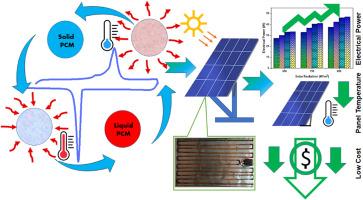Evaluating the energy and economic performance of hybrid photovoltaic thermal system integrated with multiwalled carbon nanotubes enhanced phase change material
IF 7.1
3区 材料科学
Q1 GREEN & SUSTAINABLE SCIENCE & TECHNOLOGY
引用次数: 0
Abstract
Photovoltaic thermal (PVT) systems represent an advanced evolution of traditional photovoltaic (PV) modules designed to generate electrical and thermal energy simultaneously. However, achieving optimal and commercially viable performance from these systems remains challenging. To overcome this issue, in this research, multiwalled carbon nanotube (MWCNT) enhanced phase change materials (PCMs) integrated with PVT system to enhance electrical and thermal performance has been studied. An experimental investigation with three different configurations, PVT, PCM integrated PVT (PVTPCM), and MWCNT enhanced PCM integrated PVT (PVTNePCM) systems, was carried out under varying solar radiations and a water flow rate of 0.013–0.016 kg/s compared to conventional PV system. A two-step technique was employed to formulate the nanocomposites, and the energy performance of both PV and PVT systems assessed experimentally. The performance of PVTPCM and PVTNePCM systems was evaluated using the TRNSYS simulation technique. The formulated nanocomposite exhibited a 71.43% enhancement in thermal conductivity, a significant reduction in transmittance up to 92% and remained chemically and thermally stable. Integration of NePCM in the PVT system resulted in a notable decrease in panel temperature and a 25.03% increase in electrical efficiency compared to the conventional PV system. The highest performance ratio and overall efficiency for PVTNePCM were 0.55 and 81.62%, respectively, at a flow rate of 0.013 kg/s. The energy payback periods of PVTNePCM, PVTPCM, and PVT setup were 4.7, 4.8 and 5.6 years, respectively. Additionally, a significant improvement in thermal efficiency were observed for PVTPCM and PVTNePCM systems compared to water-based PVT systems, due to the energy stored in the thermal energy storage material.

评估集成了多壁碳纳米管增强型相变材料的混合光伏热系统的能源和经济性能
光伏热能(PVT)系统是传统光伏(PV)模块的先进演进,旨在同时产生电能和热能。然而,要从这些系统中获得最佳和商业上可行的性能仍然具有挑战性。为了克服这一问题,本研究将多壁碳纳米管(MWCNT)增强型相变材料(PCMs)与 PVT 系统集成,以提高其电热性能。与传统光伏系统相比,在不同的太阳辐射和 0.013-0.016 公斤/秒的水流量条件下,对 PVT、PCM 集成 PVT(PVTPCM)和 MWCNT 增强型 PCM 集成 PVT(PVTNePCM)系统这三种不同配置进行了实验研究。采用两步法配制纳米复合材料,并通过实验评估了 PV 和 PVT 系统的能源性能。使用 TRNSYS 仿真技术评估了 PVTPCM 和 PVTNePCM 系统的性能。配制的纳米复合材料的热导率提高了 71.43%,透射率显著降低了 92%,并保持了化学和热稳定性。与传统光伏系统相比,将 NePCM 集成到 PVT 系统后,面板温度明显降低,电气效率提高了 25.03%。在流量为 0.013 公斤/秒时,PVTNePCM 的最高性能比和总效率分别为 0.55 和 81.62%。PVTNePCM、PVTPCM 和 PVT 设置的能源回收期分别为 4.7 年、4.8 年和 5.6 年。此外,与水基 PVT 系统相比,PVTPCM 和 PVTNePCM 系统的热效率明显提高,这是因为热能储存材料中储存了能量。
本文章由计算机程序翻译,如有差异,请以英文原文为准。
求助全文
约1分钟内获得全文
求助全文
来源期刊

Materials Today Sustainability
Multiple-
CiteScore
5.80
自引率
6.40%
发文量
174
审稿时长
32 days
期刊介绍:
Materials Today Sustainability is a multi-disciplinary journal covering all aspects of sustainability through materials science.
With a rapidly increasing population with growing demands, materials science has emerged as a critical discipline toward protecting of the environment and ensuring the long term survival of future generations.
 求助内容:
求助内容: 应助结果提醒方式:
应助结果提醒方式:


